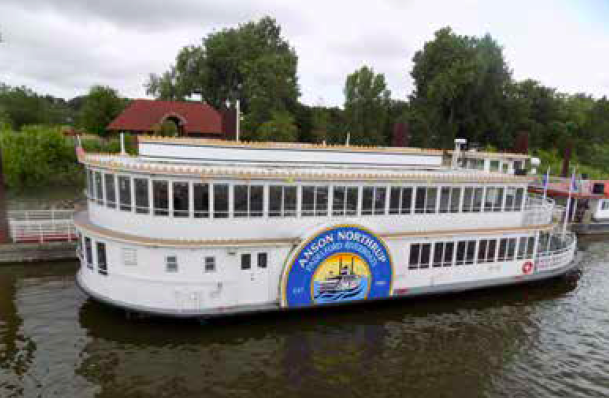What’s Next?
Last year Capt. Gus Gaspardo struggled to keep his tour boat business afloat through a season with record flooding, including three crests. About the time the flood forecasts for this season began to look promising, the COVID-19 pandemic began its surge.
Gus operates Padelford Riverboats on Harriet Island, across the Mississippi from downtown St. Paul. I began working there in 2008.
On March 15, 2020, he had to lay people off and try to determine if he would have an abbreviated or any season at all. On March 30, a 19-foot flood crest was predicted for St. Paul, soon followed by social distancing and shelter-in-place orders.
We had to cancel charters and turn away passengers three times since I started working at Padelford: in 2011, 2014, and 2019. The high water in 2014 was especially hard on the business, as several weddings had to be cut. People were incredulous that in the middle of a beautiful season, after three months of smooth sailing, we’d have to cancel on them. The office crew and Gus worked their tails off helping distraught brides find alternate venues.
That year was made more difficult because Gus had just fired the catering service and built his own galley on the wharf. All seemed about to blossom into a banner year. Then by June 23, 2014, the river had flooded Harriet Island. A team lead by Gus and his wife, Tammy, moved all the new plates, cups, glassware, and serving stuff from the land-based office onto rafts and out to boats.
For a while this spring, Gus and I were the only two people at the Padelford wharf. He was forced to lay off his core of winter employees. They all worked at maintenance and sales during the offseason. During the tour boat season, they fill in as pilots and catering crew members.

“That was one of the hardest things I’ve had to do in a long while,” he shook his head while telling me.
The two of us were using his little towboat, Ugh the Tug, to pull drift off of the upstream end of the office barge and the abandoned city dock where the Showboat once sat. We had an extra task one morning thanks to some kids who snuck down the previous night and tried to turn the boats loose in the fast currents. Fortunately most kids these days haven’t the skill to untie a knot. Now we have to wire the boats securely to the dock because Gus had reduced his insurance coverage to save money while not operating.
Gus applied for a Payment Protection Plan loan, which so many mom and pop businesses are using to try to stay afloat until this virus runs its course. As an active member and past president of the Passenger Vessel Association, Gus has been communicating with tour boat operators around the country about strategies to deal with the shutdown.
A forecast that we may see Harriet Island underwater again this spring added to his worries. So once the logs were cleared away and the boats wired to the wharf, Gus ordered a crane to lift one of the ramps to the bank, clear of the dock, for safety in case of a 16-foot flood.
In normal times Gus’ spring season kicks off with hundreds of students from around the metro area climbing aboard for Big River Journeys. For many years Padelford has partnered with the National Park Service to teach kids about their Mississippi River, but we had no students on the boats this spring.
However, Park Service ranger Lyndon Torstenson collaborated with a couple of Hamline University School of Education professors to create an online virtual experience to make up for the lost opportunity.
Professors John Shepard and Tracy Fredin set up cameras on the Betsey Northrup passenger barge. Lyndon and rangers Brian Godspeed and Abby Olson recorded their introductions to the six modules of the usual program covering aquatic invertebrates, urban pollution, how to improve water quality in your neighborhood, birds on the river, other critters like otters, and geology and how it has shaped the river. The virtual tour will be available for teachers through the Park Service and Hamline websites.
Meanwhile, all Gus could do was brainstorm contingency plans for an abbreviated or a canceled season.
“I will take a good old fashioned flood over this not knowing what is going to happen any day. Even if we do get to open up … will it be safe?”
We thought we may have to run our 600-person boat with up to a hundred passengers. We had hoped for this from rumors, but we were limited to open-air seating and 25 percent capacity. “If I run with 40 people, I just might be able to continue paying some of my bills!”
Gus was trying to hide his disappointment on the Friday before the Memorial Day weekend, “Well we might be better off than B&B boats in Cincinnati. They were planning to run Memorial Day cruises, but the Ohio River just went up damn near 20 feet since yesterday.”
Memorial Day was bittersweet for Padelford. Gus has been giving free rides to vets and their families in honor of our founder Capt. Bowell’s D-day paratroop heroics. Then on Memorial Day, a Minneapolis cop killed George Floyd, setting off protests and riots around the Twin Cities.
Late Saturday, May 30, until well after midnight I was at home listening to St. Paul Police working to block mobs trying to cross the Mississippi River at the Ford Parkway and Lake Street bridges. The Minneapolis police and National Guard were driving them east from downtown towards St. Paul.
The next day, Sunday, my wife and I were driving up Lexington Parkway in the afternoon, heading across University Avenue to babysit our grandkids. Just past Summit, a block from the governor’s mansion, we met a half-mile-long caravan of tan National Guard Humvees, some topped with turrets with some sort of barrels sticking out.
Heading back a couple of hours later, to get home before curfew, we saw those Humvees deployed along Summit and then Grand Avenue. St. Paul was on alert like we’d not seen since the Republican National Convention in 2008. That was confined to Harriet Island and downtown St. Paul. These troops and equipment are deployed across the Twin Cities.
Finally like a breath of smoke-filled air, June 1st crawled through the back door and it was time to return to the sanctity and sanctuary of the Mississippi. After the trifecta of disasters, the healing power of the first river ride of the season felt like a cool draught. The same old river seemed brand new like we had stepped into a very different stream.
